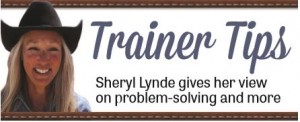 Head tossing, like any behavior, ranges in degrees of severity. One level may merely cause frustration while the next can prove to be dangerous to the owner with risk of injury.
Head tossing, like any behavior, ranges in degrees of severity. One level may merely cause frustration while the next can prove to be dangerous to the owner with risk of injury.
A common habit many riders share is leaning too far forward. Instead of riding with their shoulders behind their hips, they ride with their shoulders hovering over the saddle horn. Then, if their horse tosses his head abruptly, the rider can get a rude awakening with a pretty good crack on the skull.
When helping horses overcome unwanted behaviors, remember that the behavior is a symptom. You need to determine the cause. I always want to rule out pain, so I will first make sure their teeth are in good shape and have been floated recently. If the horse is young, up to three years old, they need their teeth checked a minimum of once every six months. They can have caps that have come partially loose and irritate the inside of the horse’s cheek, causing ulcerations. Additionally, wolf teeth need to be removed when they appear. Excessive salivating with or without the bit can also be a tip that the teeth need to be floated. Older horses can generally go nine to 12 months, but this is a generality.
If the teeth have been checked and are in good shape, then I would look at the bit. Does it fit properly? Is it too severe for the rider’s ability or the horse’s level of training?
Bits serve as successful training aids when used as they were designed to be used. Leverage bits have an unfair reputation for being severe, but it isn’t the bit — it’s the rider’s hands. If you are in question about the bit you are using, check with a professional trainer.
Once pain has been ruled out, then typically head tossing is caused by the rider’s hands. If the rider is riding with the top half of the body only, from the waist up, then they are constantly balancing on the horse’s mouth. It is their one source of control. They pull on the reins when they are nervous — to slow down or to balance when trotting or cantering. The horse never experiences a release, only constant contact with the rider’s hands. This will begin frustration in the horse, and he’ll launch a counterattack by tossing his head in order to get the rider’s hands out of his mouth. As he does this, he will experience temporary relief, as the rider loses their balance and loosens their grip momentarily. Now, with this small modicum of success, the battle is on.
Having identified the cause, let’s look at the fix. The equipment of choice will be the snaffle because often a horse that has been ridden with constant contact is inflexible and unbending — similar to riding a steel beam. The snaffle is an excellent bit to use for lateral work and to separate the five body parts: the head, neck, shoulder, rib cage and hind quarters.
In the arena, I ride with a loose rein and let the horse move. Because of being micromanaged, he will wander about like a drunken sailor; he doesn’t know what to do with the freedom of the loose rein. Let him be. I urge him into a trot and guide him in the opposite direction he wants to go by using my seat and legs. If he wants to veer off to the left, I will use my right leg and pick up the left rein and guide him to the left and release. If I pick up on the left rein and he tosses his head, I will anchor my hand on the pommel of my saddle and hold firm until he gives up the head toss. When he is quiet and moving to the left, I will immediately release. Your hand has to be firm during the head toss. By keeping it firm, your horse will give up. But if he can pull your hand and feel any type of give, then there is enough hope for him to continue the behavior.
Imagine if you are trying to pull up a post that is firmly set in concrete. It doesn’t move. You will give up your effort pretty quick. But if the post has some give to it, you will keep at because you can feel movement. So, keep your hand firm. If he speeds up without being asked, I would sit deep in the saddle, relax my legs and pull him to a one-rein stop, asking him to flex laterally. As soon as he softens, I release the rein and ask him to move off.
Training takes time! I repeat all the above until he guides on a loose rein from my seat and legs. The head toss usually disappears on its own.
Sheryl
Leave a Comment
All fields must be filled in to leave a message.